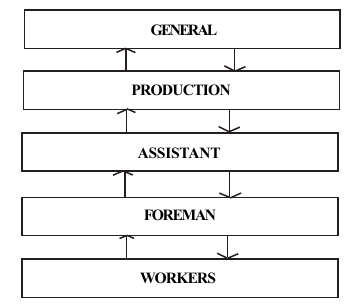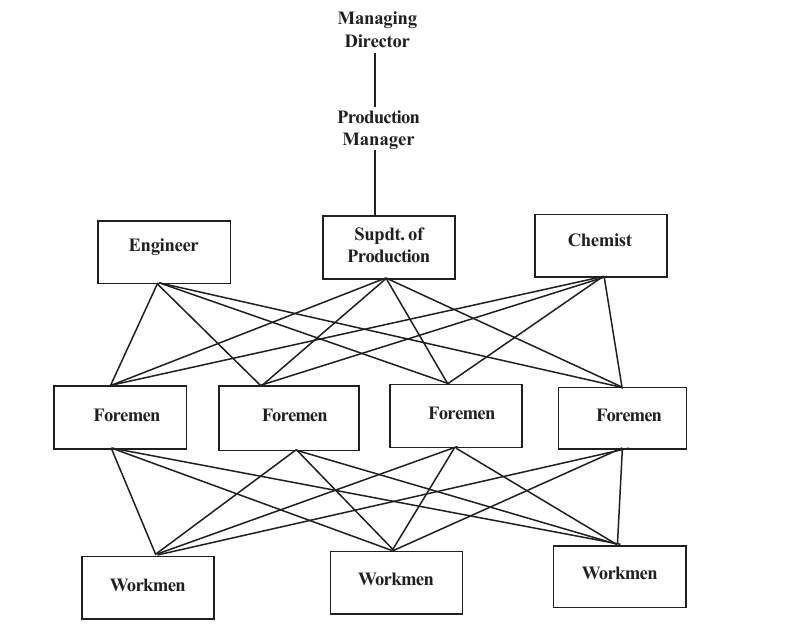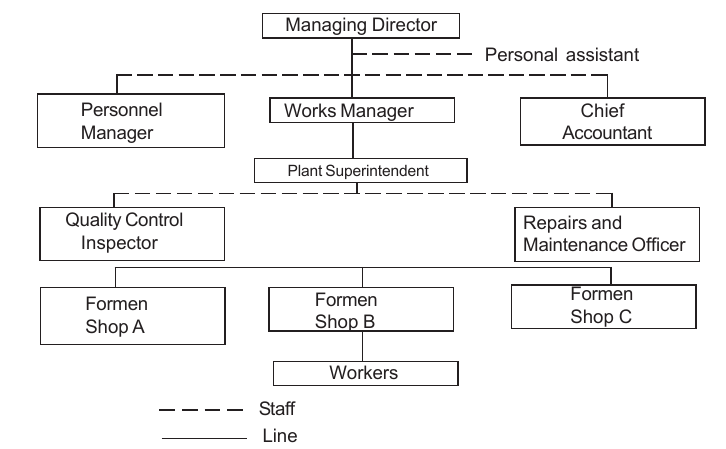Answer:
The various forms of internal organisation or patterns of organisation structure are given below:
- Line organisation
- Functional organisation
- Line and staff organisation
- Committee organisation
- Project organisation
- Matrix organisation
Line organisation:
Line organisation is the oldest type of organisation. It is also known as scalar or military organisation. In this type of organisation, there is a vertical line of authority running from the top to bottom of organisation.

The man at the top has the highest authority and it is reduced to each successive level down the hierarchy. Every person is in direct chain of command. He gets orders from the man immediately above him and is directly accountable to only one superior.
Advantages:
Line organisation offer the following benefits:
- It is very simple to establish and can be easily understood by employees.
- The authority and responsibility of each position is clearly defined. Each individuals knows to whom he is responsible.
- It facilitates prompt decisions and speedy action is possible.
- There is unity of command and each executive has full control over his subordinates.
- It ensures better discipline.
- Each individual can be held accountable for results and he cannot shift his responsibility to others.
- It is very economical.
Limitations:
Line organisation suffers from the following draw backs:
- There is lack of specialisation
- Key executives are over burdened with administrative work.
- It may result in autocratic control.
- Subordinates may lose initiative and independent thinking.
- Line organisation may lack stability and continuity.
- Thus line organisation is suitable for small concerns employing few persons and carrying on routine work.
Functional Organisation:
Functional organisation is based on the concept of “Functional Foremanship” developed by F.W. Taylor. Under functional organisation, the organisation is divided into a number of functional areas. Each function is managed by an expert in that area. Every functional area serves all other areas in the organisation.

For example, the purchase department handles purchases for all departments. The executive in charge of a particular function issues orders throughout the organisation with respect to his function only. Thus, an individual in the organisation receives instructions from several functional heads.
Advantages:
Functional organisation contains the following benefits:
- Functional organisation promotes division of work which leads specialisation.
- Every functional head looks after only one function, therefore, burden on top executives is reduced.
- Control becomes more effective.
- Recruitment, selection and training of managers is simplified because, each individual is required to have knowledge of one functional area only.
- Every individual in the organisation concentrates on one function only, which ensures higher efficiency.
- It adopts scope for expansion and growth of the organisation.
Disadvantages:
Functional organisation suffers from the following weakness:
- A person may be accountable to several superiors. In the absence of unity of command, responsibility for results cannot be fixed easily.
- There are many cross-relationships which create confusion.
- Decision-making process in functional organisation is slow.
- Executives at the lower level do not get opportunity of all round experience.
- Functional organisation lacks co-ordination among various departments. Functional organisation is generally suitable for large and medium sized concerns.
Line and Staff Organisation:
Line and staff organisation is a combination of line and functional structures. Under it, line authority flows in a vertical line in the same manner as in the line organisation. In addition, staff specialists are attached to line positions to advise them on important matters. These specialists do not have power of command over subordinates in other departments.

They are purely of advisory nature. Staff positions are created to support the line managers. Staff specialists has only advisory relationship with other departments.
Advantages:
- Line and staff organisation offer the following advantages:enabled to discharge their responsibilities more efficiently.
- Staff specialists carryout detailed investigation and supply needed information to line executives. Therefore, the burden of line executives is reduced.
- Staff specialists provide adequate information and expert advice. As a result line executive can take better decisions.
- As every executives concentrates in one field, he acquires valuable experience.
- Line and staff organisation is comparatively more flexible.
Disadvantages:
Line and staff organisation suffers from the following drawbacks:
- Conflicts often arise between line managers and staff specialists.
- In actual practice, it is often very difficult to define clearly the authority relationships between line and staff officials. In the absence of clear allocation of duties, coordination becomes difficult.
- Staff personnel are not accountable for the results. Therefore they may not take their tasks seriously.
Committee Organisation:
A committee is a group of persons formed to discuss and deliberate on problems and to recommend or decide solutions. Its area of operation is determined by its constitution. It may be authorised to deal with all or specific activities. Members of the committee have authority to go into details of the problems. A committee may be constituted at any level of organisation and its members may be drawn from various departments.
Advantages:
Committees are used in management for the following reasons:
- Committee’s decisions are more balanced, logical and objective.
- Committees ensure effective co-ordination among different departments.
- By allowing the people to participate in the decision making process, committee help to improve the loyalty and commitment of employees.
- It avoids conflicts among group members.
- By serving on various committees, managers acquire valuable experience.
- Committees are useful for quick transmission of information throughout the organisation.
- Committee may be constituted to cool of agitations and to overcome resistance.
Disadvantages:
Committee suffer from the following limitations:
- Committee meetings are a costly affair both in terms of money and time.
- The functioning of committee is slow and it cannot take quick decisions.
- A committee decision is not necessarily the best decision but merely on acceptable one.
- A strong personality member dominates the committee action.
- The responsibility for wrong decisions by a committee cannot be fixed on any one individual.
- Committees are sometimes misused to avoid action, to take unpleasant decisions or to delay decisions.
Total Views: 37
